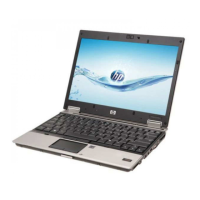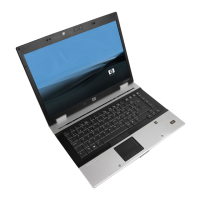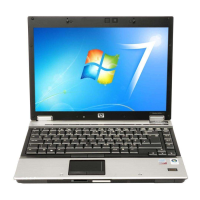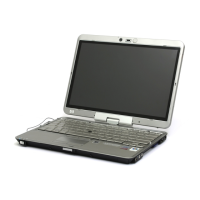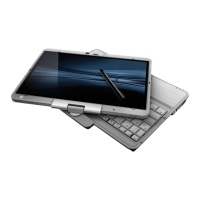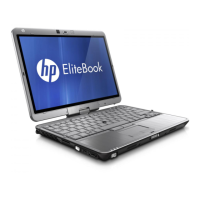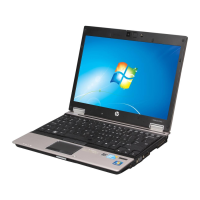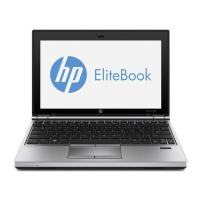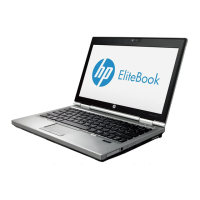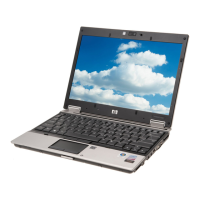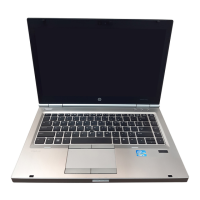
Do you have a question about the HP 2730p - EliteBook - Core 2 Duo 1.86 GHz and is the answer not in the manual?
| Graphics | Intel GMA 4500MHD |
|---|---|
| Processor | Intel Core 2 Duo 1.86 GHz |
| Display | 12.1-inch WXGA (1280 x 800) |
| RAM | Up to 8 GB DDR2 |
| Storage | 120 GB HDD |
| Operating System | Windows Vista Business |
| Weight | 3.7 lbs |
| Battery | 6-cell Lithium ion |
| Networking | 802.11a/b/g/n, Bluetooth 2.1 |
| Ports | 3 x USB 2.0, VGA |
| Optical Drive | External DVD+/-RW |
Overview of WLAN, WWAN, and Bluetooth devices and their basic functions.
Details common WLAN standards like 802.11b, g, a, and n with their specifications.
Explains icons for wireless and network connection status (connected/disconnected).
Use wireless button, Wireless Assistant, and HP Connection Manager for control.
Utilize OS features for managing wireless connections.
The wireless light indicates the overall power status of wireless devices.
Use the button to turn wireless devices on or off simultaneously.
View wireless device status via notification icon or software interface.
Get further information by accessing the Wireless Assistant Help feature.
Start HP Connection Manager via notification icon or Start menu.
Use Windows Network Connections for managing wireless connections.
Explains WLANs, their components, and different scale types.
Connection to a WLAN infrastructure is required to use the WLAN device.
Lists necessary items: modem, Internet service, router, computer.
Illustrates a typical wireless network installation connected to the Internet.
Discusses WLAN vulnerabilities and public hotspot security.
Implement security features like firewalls, encryption, and disabling SSID broadcast.
Ensure the WLAN device is active and verify connection status.
Select WLAN, enter security key, and confirm connection.
Addresses issues like no WLANs listed or range factors.
Windows automatically connects to new WLANs when available.
Reconnect manually if Windows does not recognize a new network.
Access Internet via WWAN for extended coverage compared to WLAN.
Details HSPA and EV-DO technologies used in mobile broadband.
Discusses SIM card necessity for activation and its stored information.
CAUTION: Use minimal force to prevent damage to SIM connectors.
Step-by-step guide for safely inserting the SIM card.
NOTE: Battery must be replaced for HP Mobile Broadband to function.
Step-by-step guide for safely removing the SIM card.
WARNING: Minimize antenna contact; follow positioning guidelines for safety.
Position antenna at 180 degrees (tablet) or 90 degrees (notebook) for safe use.
Press release button and lift antenna to upright position.
In notebook mode, position the antenna at a 90-degree angle.
WARNING: Keep antenna 2.5 cm from body; avoid pointing towards you.
Ensure no active WWAN connection before pressing antenna down to close.
Steps for removing the antenna and connecting it securely.
Bluetooth enables short-range wireless communication for electronic devices.
Devices create peer-to-peer PANs for easy connectivity.
HP does not recommend using Bluetooth as a gateway for ICS.
Bluetooth excels at synchronizing data between devices.
Issues include installation, hardware, configuration, and interference problems.
Confirm all wireless device drivers are installed before troubleshooting.
Verify WLAN device installation and identify it in Device Manager.
Address problems indicating no WLAN or improper driver installation.
Windows can automatically repair corrupted WLAN connections.
Use notification icon or Control Panel to repair network connections.
A missing icon indicates a corrupted or missing software driver.
Obtain and install latest WLAN software from the HP support website.
Secure networks need correct SSID and network keys for access.
Obtain and update network security codes from router guides or administrators.
Minimize interference and move closer to router for weak signals.
Reset or restart the wireless router if connection fails.
